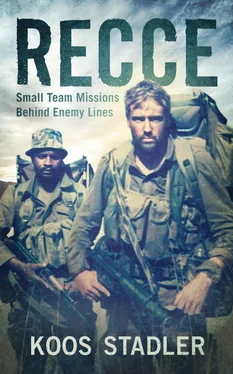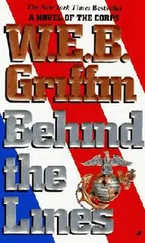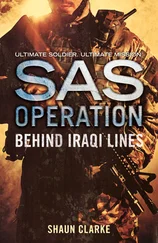The Cubans were notorious for boozing and taking drugs, and the chances of them carousing with their FAPLA comrades were a hundred to one. Indeed, as we approached the Cuban base among the bluegum trees, we could hear loud Spanish music and drunken voices singing along. There was clearly a party on the go, and we decided to hang around and listen for a while. It was still early and we had to wait for the right time to penetrate. The merry mood continued, and we decided that the Cuban contingent posed no threat that night.
Following the railway line, we moved further east towards the target. At 23:00 we left the tracks and turned north on a bearing to the point where we wanted to cross the perimeter fence. I took the lead, as this was pure DR navigation and we needed to find the exact penetration point in the pitch dark. Furthermore, we needed to navigate accurately to the aircraft parked on the eastern apron of the runway, approximately 1 500 m north of the crossing point. Once the charges were placed, we would have to navigate back to the point of penetration.
We reached the perimeter fence by 23:30 and decided to stay put and listen for a while. Just as we had settled down, a patrol of six guards passed us on the vehicle track inside the fence line. They walked quietly, without talking, which meant that they would probably have picked us up had we started cutting the fence earlier. We gave them a few minutes to disappear and decided to cross before the next patrol came around.
During the rehearsals we had practised a technique in which Diedies would hold the fence down with his gloved hands while I did the cutting. This would prevent the taut wires from snapping with a twang that (as we knew from previous experience) could alert the whole of southern Angola. However, we soon discovered that the fence wire was not taut at all and that I could cut it alone – while covering the clipping noise with a cloth brought exactly for this purpose. Diedies moved back into the brush to listen for further patrols.
It was slow work, as each strand of cut wire had to be treated carefully. I did not want to make any noise, and the loose part of the fence had to be folded back and tied into position with the strands of cut wire to make it as inconspicuous as possible. By 00:30 the hole was ready, and we entered as quietly and as quickly as possible, careful not to leave any tracks on the ground. I folded the loose fencing back and tied it in its original position. In the dark it would pass as untouched, and we intended to use it as an escape in case of an emergency.
I navigated past some bunkers, possibly an ammunition store for the fighter aircraft ordnance, which we could not recall from the aerial photos. Once again I moved without the night-vision goggles, while Diedies scanned the night with his goggles to locate any sign of danger. I had my AMD at the ready, while Diedies moved with silenced sub-machine gun. We reached the hardstand by 01:00 without encountering any guards. Using the night vision, we could make out a MiG-21, barely 30 m away, crouched on the tarmac against the skyline, with the dark shape of another aircraft further off. We crouched down in the low bushes bordering the tarmac and quietly discussed our approach, as well as our escape route and emergency RV – which would be the hole in the fence where we had entered.
I would take the first aircraft, and then we would work our way down the line of fighters along the tarmac. We decided against the initial option of splitting up to reach more planes in the shortest possible time; in the darkness it was impossible to determine separate lines of targets for each operator.
Silently, with deliberate, slow movements, I slid my pack off and took out the first charge, together with a set of glue tubes. With practised fingers I undid the straps of the pouches and arranged the rest of the charges so they would be within easy reach. I felt strangely calm and ready for the task at hand. The overwhelming fear I had experienced in the past was absent. Instead, a sense of sheer dedication to get the job done had taken over. Deep inside I knew that I was exceptionally well prepared for this, and that the stakes were too high to fail.
Diedies positioned himself on the edge of the tarmac to listen out and warn me if anyone approached. Quietly, I slipped the charges back on and draped my AMD in a fireman’s sling down the centre of my back to allow freedom of movement. Then I started the stalk towards the aircraft, silenced pistol cocked and ready in the right hand, charge in the left and night-vision goggles on my chest.
Ten metres from the aircraft I stopped to observe with the night-vision goggles. The darkness of the night was absolute, as we had hoped, but it also meant that I could not see below the fuselage. Not even with the beam of the infrared torch could the night-vision goggles penetrate the complete blackness under the belly of the MiG-21.
The night was dead silent. There was no sound from underneath the aircraft, nor could I make out any shape under the belly. I realised I needed to go lower to observe better. Slowly, and as quiet as a mouse, I eased forward to move into the blackness under the fuselage so I could look up against the ambient light of the sky.
I crouched to move in under the wing.
Then a voice pierced the silence of the night from the darkness underneath the plane. My worst fear was coming true.
“Quem são você…?” The voice was hesitant at first, restrained with fear.
Then stronger: “Quem são você? [Who are you?]”
Then the all-too-familiar cocking of a Kalashnikov shattered the fragile night air, barely three metres away under the belly of the aircraft, cracking like a rifle shot in the darkness.
As so often before, I was confronted in the pitch dark with the penetrating, nerve-racking sound of an AK-47 being cocked in my face as I crept around in an enemy base. This time I also felt exposed against the night sky on the open tarmac. My own weapon was slung on my back; the silenced pistol in my hand was of no use if I couldn’t even see my adversary.
The guard’s voice now became bold and challenging: “Onde você vai? [Where are you going?]”
A second AK was cocked as if to bolster the challenge.
The long hours of rehearsals during those dark nights at Hoedspruit Air Force Base kicked in – instantly and instinctively. In a split second I had covered all the options in my mind – the shortest route to safety, the best course of action in case of white light, the most effective way to present myself as the smallest target possible. I mumbled drunkenly in Portuguese, automatically recalling the phrases we had rehearsed so often: “Companheiro, o que você faz…? [Comrades, what are you doing…?]”
At the back of my mind, I knew from previous experience that they would not open fire immediately. I knew my enemy was scared and uncertain. They could not see me clearly and had no idea who I was. I had to move now.
This was my only chance.
Keeping up my incoherent babbling, I pretended to stumble, and in the process ducked low down on the tarmac, reducing the clear target my silhouette presented against the skyline. Going low, I crawled back towards our RV, where Diedies waited anxiously. He had heard the encounter and was ready to move. We hurriedly discussed our options and waited for reaction from the guards. Although we could not see anything, we heard muffled sounds coming from the direction of the aircraft. Could we exploit their confusion and move round to the aircraft on the far side? Soon we saw movement against lighting in the distance, and then our minds were made up for us as a vehicle with a spotlight started moving along the tarmac in the direction of the hardstand.
We knew we had to get out of there. “The hole in the fence… We have to find the hole in the fence!” Diedies whispered.
Читать дальше












